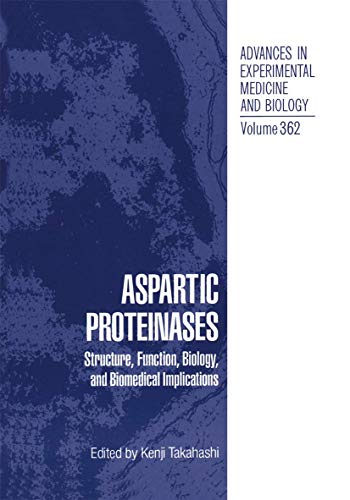Articoli correlati a Aspartic Proteinases: Structure, Function, Biology,...

Le informazioni nella sezione "Riassunto" possono far riferimento a edizioni diverse di questo titolo.
Le informazioni nella sezione "Su questo libro" possono far riferimento a edizioni diverse di questo titolo.
- EditoreSpringer Nature
- Data di pubblicazione2012
- ISBN 10 1461357616
- ISBN 13 9781461357612
- RilegaturaCopertina flessibile
- Numero di pagine656
- RedattoreTakahashi Kenji
Compra nuovo
Scopri di più su questo articolo
Spese di spedizione:
GRATIS
In U.S.A.
I migliori risultati di ricerca su AbeBooks
Aspartic Proteinases: Structure, Function, Biology, and Biomedical Implications (Advances in Experimental Medicine and Biology) [Paperback ]
Print on DemandDescrizione libro Soft Cover. Condizione: new. This item is printed on demand. Codice articolo 9781461357612
Aspartic Proteinases: Structure, Function, Biology, and Biomedical Implications (Advances in Experimental Medicine and Biology, 362)
Descrizione libro Condizione: New. Codice articolo ABLIING23Mar2716030032468
Aspartic Proteinases
Descrizione libro Condizione: New. Codice articolo 4193983
Aspartic Proteinases: Structure; Function; Biology; and Biomedical Implications
Print on DemandDescrizione libro Condizione: New. PRINT ON DEMAND Book; New; Fast Shipping from the UK. No. book. Codice articolo ria9781461357612_lsuk
Aspartic Proteinases : Structure, Function, Biology, and Biomedical Implications
Descrizione libro Taschenbuch. Condizione: Neu. Druck auf Anfrage Neuware - Printed after ordering - The 5th International Conference on Aspartic Proteinases was held on September 19 through 24, 1993, at Naito Museum of Pharmaceutical Science and Industry, Kawashima cho, Gifu Prefecture, Japan, about 15 miles northwest of Nagoya City. About 100 scientists attended the conference, including 52 from 14 countries outside Japan, and 32 papers were presented by invited speakers, and 58 papers as posters. The purpose of this conference was to present and discuss new information on the structure, function, and biology, and related topics, including biomedical implications, of aspartic proteinases, and this book is a collec tion of nearly all the papers presented at the meeting. Aspartic proteinases belong to one of the four major classes of proteinases, the others being serine, cysteine, and metalloproteinases, and are so called since they have two catalytic aspartic acid residues in common in their active sites. Most of them are optimally active at acidic pH, hence the long-used name 'acid proteinases,' which, indeed, was the major title of the first conference of this series. However, some of them are active at around neutral pH, indicating their physiological roles in a wider range of pH than hitherto considered. Codice articolo 9781461357612
Aspartic Proteinases: Structure, Function, Biology, and Biomedical Implications
Descrizione libro Paperback. Condizione: Brand New. reprint edition. 656 pages. 9.45x6.61x1.32 inches. In Stock. Codice articolo x-1461357616
Aspartic Proteinases
Descrizione libro Taschenbuch. Condizione: Neu. This item is printed on demand - it takes 3-4 days longer - Neuware -The 5th International Conference on Aspartic Proteinases was held on September 19 through 24, 1993, at Naito Museum of Pharmaceutical Science and Industry, Kawashima cho, Gifu Prefecture, Japan, about 15 miles northwest of Nagoya City. About 100 scientists attended the conference, including 52 from 14 countries outside Japan, and 32 papers were presented by invited speakers, and 58 papers as posters. The purpose of this conference was to present and discuss new information on the structure, function, and biology, and related topics, including biomedical implications, of aspartic proteinases, and this book is a collec tion of nearly all the papers presented at the meeting. Aspartic proteinases belong to one of the four major classes of proteinases, the others being serine, cysteine, and metalloproteinases, and are so called since they have two catalytic aspartic acid residues in common in their active sites. Most of them are optimally active at acidic pH, hence the long-used name 'acid proteinases,' which, indeed, was the major title of the first conference of this series. However, some of them are active at around neutral pH, indicating their physiological roles in a wider range of pH than hitherto considered. 656 pp. Englisch. Codice articolo 9781461357612

